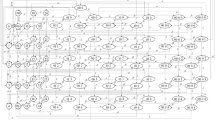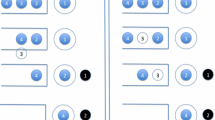Abstract
Ticket queues are popular in many service systems. Upon arrival, each customer is issued a numbered ticket and receives service on a first-come-first-served basis according to the ticket number. There is no physical queue; customers may choose to walk away and return later (before their numbers are called) to receive service. We study the problem of optimal staffing in such a system with two capacity levels, where the staffing decision can only be based on ticket numbers, as opposed to the physical queue length in a traditional system. Using renewal reward theorem, we first derive the long-run average total cost (including customer delay and abandonment costs, operating cost and cost for changing staffing levels) and then obtain the optimal solution using fractional programming. In addition, we pursue a random-walk analysis, which leads to some highly accurate approximations.







Similar content being viewed by others
References
Ancker, C.J., Jr., Gafarian, A.V.: Some queuing problems with balking and reneging. I. Oper. Res. 11(1), 88–100 (1963)
Ancker, C.J., Jr., Gafarian, A.V.: Some queuing problems with balking and reneging. II. Oper. Res. 11(6), 928–937 (1963)
Armony, M., Plambeck, E., Seshadri, S.: Sensitivity of optimal capacity to customer impatience in an unobservable \(M/M/S\) queue (Why you shouldn’t shout at the DMV). Manuf. Serv. Oper. Manag. 11(1), 19–32 (2009)
Baccelli, F., Boyer, P., Hebuterne, G.: Single-server queues with impatient customers. Adv. Appl. Probab. 16(3), 887–905 (1984)
Bell, C.E.: Turning off a server with customers present: is this any way to run an \(M/M/c\) queue with removable servers? Oper. Res. 23(3), 571–574 (1975)
Borst, S., Mandelbaum, A., Reiman, M.I.: Dimensioning large call centers. Oper. Res. 52(1), 17–37 (2004)
Brown, L., Gans, N., Mandelbaum, A., Sakov, A., Shen, H., Zeltyn, S., Zhao, L.: Statistical analysis of a telephone call center: a queueing-science perspective. J. Am. Stat. Assoc. 100(1), 35–50 (2005)
Cox, D.R., Smith, W.L.: Queues. CRC Press, Florida (1961)
Fu, M.C., Marcus, S.I., Wang, I.: Monotone optimal policies for a transient queueing staffing problem. Oper. Res. 48(2), 327–331 (2000)
Gans, N., Zhou, Y.: A call-routing problem with service-level constraints. Oper. Res. 51(2), 255–271 (2003)
Garnett, O., Mandelbaum, A., Reiman, M.: Designing a call center with impatient customers. Manuf. Serv. Oper. Manag. 4(3), 208–227 (2002)
Gavish, B., Schweitzer, P.J.: The Markovian queue with bounded waiting time. Manag. Sci. 23(12), 1349–1357 (1977)
Gnedenko, B.V., Kovalenko, I.: Introduction to Queueing Theory. Birkhauser Boston Inc., Boston (1989)
Halfin, S., Whitt, W.: Heavy-traffic limits for queues with many exponential servers. Oper. Res. 29(3), 567–588 (1981)
Harrison, J.M., Zeevi, A.: A method for staffing large call centers based on stochastic fluid models. Manuf. Serv. Oper. Manag. 7(1), 20–36 (2005)
Hokstad, P.: A single server queue with constant service time and restricted accessibility. Manage. Sci. 25(2), 205–208 (1979)
Huang, J., Mandelbaum, A., Zhang, H., Zhang, J.: Refined models for efficiency-driven queues with applications to delay announcements and staffing. Oper. Res. 65(5), 1380–1397 (2017)
Jennings, O.B., Pender, J.: Comparisons of ticket and standard queues. Queueing Syst. 84(1), 145–202 (2016)
Mandelbaum, A., Shimkin, N.: A model for rational abandonments from invisible queues. Queueing Syst. 36(1–3), 141–173 (2000)
Mandelbaum, A., Zeltyn, S.: Staffing many-server queues with impatient customers: constraint satisfaction in call centers. Oper. Res. 57(5), 1189–1205 (2009)
Omahen, K., Marathe, V.: Analysis and applications of the delay cycle for the \(M/M/c\) aueueing system. J. Assoc. Comput. Mach. 25(2), 283–303 (1978)
Pang, G., Perry, O.: A logarithmic safety staffing rule for contact centers with call blending. Manag. Sci. 61(1), 73–91 (2015)
Reynolds, J.F.: The stationary solution of a multiserver queueing model with discouragement. Oper. Res. 16(1), 64–71 (1968)
Ross, S.M.: Stochastic Processes. John Wiley & Sons, INC., New Jersey (1996)
Stanford, R.E.: Reneging phenomenal in single-server queues. Math. Oper. Res. 4(1), 162–178 (1979)
Topkis, D.: Supermodularity and Complementarity. Princeton University Press, New Jersey (1998)
Van Dijk, N.M.: Queueing systems with restricted workload: an explicit solution. J. Appl. Probab. 22(2), 393–400 (1990)
Xu, S., Gao, L., Ou, J.: Service performance analysis and improvement for a ticket queue with balking customers. Manag. Sci. 53(2), 971–990 (2007)
Yadin, M., Naor, P.: On queueing systems with variable service capacities. Naval Res. Logist. Quart. 14(1), 43–53 (1967)
Zhang, B., van Leeuwaarden, J., Zwart, B.: Staffing call centers with impatient customers: refinements to many-server asymptotics. Oper. Res. 60(2), 461–474 (2012)
Zhang, Z.G.: Performance analysis of a queue with congestion-based staffing policy. Manag. Sci. 55(2), 240–251 (2009)
Zohar, E., Mandelbaum, A., Shimkin, N.: Adaptive behavior of impatient customers in tele-queues: theory and empirical support. Manag. Sci. 48(4), 566–583 (2002)
Author information
Authors and Affiliations
Corresponding author
Additional information
Publisher's Note
Springer Nature remains neutral with regard to jurisdictional claims in published maps and institutional affiliations.
Smeal College of Penn State U was the last academic affiliation of the late Professor Susan Xu.
7 Appendix
7 Appendix
Proof of Lemma 1
First we look at \(\mathsf{E}T_{11}\). Let \(\widetilde{\mathbf{D}}_1\) be the \(N\times N\)-dimensional matrix obtained by removing the entries in generator \(\mathbf{D}\) associated with state \((1,N+1)\):

From the phase-type distribution theory,
where \({\mathbf {e}}'\) is the transpose of the \(N-\)dimensional unit vector. It is direct to verify the inverse of \(\widetilde{\mathbf{D}}_1\), denoted by \(\widetilde{\mathbf{D}}_1^{-1}=(\widetilde{d}_{ij})_{N\times N}\), can be written as

\(\mathsf{E}T_{11}\) directly follows (7.2)–(7.3). Note that the expectation of \(T_{12}\) is \((1+\mathsf{E}X)\) multiplied by \(\mathsf{E}T_{11}\) replacing \(\theta _1\) and \(\rho _1\) by \(\theta _2\) and \(\rho _2\), respectively. Hence, \(\mathsf{E}T_{12}\) can be obtained by (7.2)–(7.3) replacing \(\theta _1\) and \(\rho _1\) by \(\theta _2\) and \(\rho _2\), respectively. \(\square \)
Proof of Lemma 3
First we consider the customer delay cost incurred by the period \(T_{11}\). For the Markov chain \(\{(S_1(t),S_2(t),Q(t)), t\ge 0\}\) given in (2.2) starting with state \((1,0,L+1)\), let V(1, 0, i) be the number of visits to state (1, 0, i) during \(T_1\), \( i=0,\cdots , N.\) In view of the definition of \(\widetilde{\mathbf{D}}_1^{-1}\) given by (7.3). Let \(f_{L+1,i}\) be the probability that the chain visits state (1, 0, i) from state \((1,0,L+1)\) and \(f_{i,i}\) the probability that the chain revisits state (1, 0, i), \(i=0,1,\cdots , N\). From the theory of absorbing property of the first passage probability of the transient Markov chain, we know that V(1, 0, i) is a geometric random variable with
The first passage probabilities \(f_{L+1,i}\) and \(f_{ii}\) can be computed by
Here, \(p^n_{ij}\) is the n-step transition probability for the transition probability matrix given by
Here \(\widetilde{\mathbf{D}}_1\) is given by (7.1), and I is an identity matrix. This implies
In view of (7.3), we have
We have
This implies that the expected sojourn times in states (1, i) are
Given the ticket queue length i, the corresponding number of waiting customers follows a binomial distribution with mean \((1-{\alpha }_1)i\). Then, the customer delay cost in \(T_{11}\) is
The customer delay cost in \(T_{12}\) can be obtained by (7.5) in which \(\mu _1\) is replaced by \(\mu _2\). Hence the proof of the lemma is completed. \(\square \)
Proof of Lemma 4
First, according to Theorem 1 of Omahen and Marathe [21],
The Laplace–Stieltjes transform of \(T^{(s)}_{21}\) is given by
This implies
Using (7.6), we have
By (2.6),
Hence, the lemma for \(L>-1\) follows from \(T^{(s)}_{23}=0\), (2.14) and (7.8).
Now we consider the case \(L=-1\). According to the definition of \(T^{(s)}_{23}\) and \(\tau _{11}\) and \(\tau _{12}\) in (2.6), we have
Taking derivative with resect to “s" in (2.8)–(2.9), we have
Therefore, we can write down \(\mathsf{E}\Big (W|\text { arriving during } \tau _{11} \Big )\) and \(\mathsf{E}\Big (W|\text { arriving during } \tau _{12} \Big )\) as
By Theorem 2 of Omaben and Marathe (1978),
Hence, we have
Recalling from (2.6) that
we know that
Combining (7.10)–(7.12) yields that
The lemma for \(L=-1\) directly follows from (2.14) and (7.8). \(\square \)
Proof of Lemma 6
In view of Lemma 3, we know that
By (7.3)–(7.4), we have the lemma for \(\mathsf{E}T_{10}\). Now consider \(\mathsf{E}T_{20}\). Let \(\tau ^{(0)}_{1i}\) is the accumulative time for one server idle during \(\tau _{1i}, i=1,2\). Then we have
This gives that
which prove the lemmas for \(\mathsf{E}T_{20}\). \(\square \)
Proof of Lemma 7
The first three results directly follow from the random-walk theory (see, for example, [24]). (iv), by noting that T is a stopping time for the sequence \(\{Y_n, n\ge 1\}\), follows from Wald’s equation. Now we show (v). Let \({{{\mathcal {F}}}}_n\) be the sigma field generated by \(\{(X_i,Y_i),i=1,\dots ,n \}\). Note both \(\{S_n\}\) and \(\{Y_n\}\) are adapted to the filtration \(\{ {\mathcal {F}}_n, n\ge 1 \}\). Hence
where we use the fact that \(Y_n\) is independent of \({\mathcal {F}}_{n-1}\). Taking expectation on both sides of (7.13), we have
Hence,
Now we consider \({E}\Big (\sum _{i=1}^{T}S_i\Big )\). Write \(X_i=\xi _i+\gamma \), where \(\xi _i\)’s are i.i.d., and \({E}\xi _i=0\), \(\textsf {Var}(\xi _i)=\sigma ^2\), we have
The last term above is a martingale. Hence
Applying optimal stopping theorem to the martingale \(\{ (S_n-n\gamma )^2-n\sigma ^2 \}\) yields
Plug (7.16) into (7.15), and we have
Since, by \(\mathsf{E} S_T=\gamma \cdot \mathsf{E} T=A\pi _A-B(1-\pi _A)\),
we simplify \({E}\Big (\sum _{i=1}^{T}S_i \Big )\) as
Thus, by (7.14), we have
This gives (v). Therefore, the lemma is proved. \(\square \)
Proof of Lemma 8
Going along the line of the proof of Lemma 7, the lemma can be proved similarly. \(\square \)
Rights and permissions
Springer Nature or its licensor holds exclusive rights to this article under a publishing agreement with the author(s) or other rightsholder(s); author self-archiving of the accepted manuscript version of this article is solely governed by the terms of such publishing agreement and applicable law.
About this article
Cite this article
Xiao, L., Xu, S.H., Yao, D.D. et al. Optimal staffing for ticket queues. Queueing Syst 102, 309–351 (2022). https://doi.org/10.1007/s11134-022-09854-8
Received:
Revised:
Accepted:
Published:
Issue Date:
DOI: https://doi.org/10.1007/s11134-022-09854-8




